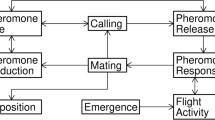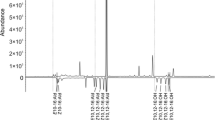Abstract
Field results have shown that male moths of some species are not always trapped by the ratio of pheromone components produced by the female moths. For cases involving a binary mixture of geometrical or positional isomers, this phenomenon may be explained by use of a threshold diagram in which the isomer ratio in the mixture is plotted against release rate (concentration). In this diagram an “attraction area” is bounded by the threshold for flight activation over the full range of binary mixtures and by the threshold for alteration of in-flight behavior (disorientation) by each pheromone component. A low release rate of the natural mixture may fall within this “attraction area,” or a high release rate of mixtures in certain other ratios may fall within this area and would be expected to attract male moths. This hypothesis has been used to explain heretofore anomalous trapping data with some moth species, and it can be useful in future studies on defining pheromone blends, species specificity, and potentially disruptive mixtures for insect control.
Similar content being viewed by others
References
Baker, J.L., Hill, A.S., andRoelofs, W.L. 1978. Seasonal variations in male omnivorous leafroller moth trap catches with pheromone component mixtures.Environ. Entomol. 7:399–401.
Baker, T.C., Cardé, R.T., andRoelofs, W.L. 1976. Behavioral responses of maleArgyrotaenia velutinana (Lepidoptera: Tortricidae) to components of its sex pheromone.J. Chem. Ecol. 2:333–352.
Bierl, B.A., Beroza, M., Staten, R.T., Sonnet, P.E., andAdler, V.E. 1974. The pink bollworm sex attractant.J. Econ. Entomol. 67:211–216.
Flint, H.M., Smith, R.L., Forey, D.E., andHorn, B.R. 1977. Pink bollworm: response of males to (Z,Z-) and (Z,E-) isomers of gossyplure.Environ. Entomol. 6:274–275
Hill, A.S., andRoelofs, W.L. 1975. Sex pheromone components of the omnivorous leafroller moth,Platynota stultana.J. Chem. Ecol. 1:91–99.
Marks, R.J. 1976. Laboratory evaluation of the sex pheromone and mating inhibitor of the red bollworm,Diparopsis castanea Hampson (Lepidoptera, Noctuidae).Bull. Entomol. Res. 66:427–435.
Miller, J.R., andRoelofs, W.L. 1977. Sex pheromone titer correlated with pheromone gland development and age in the redbanded leafroller moth,Argyrotaenia velutinana.Ann. Entomol. Soc. Am. 70:136–139.
Miller, J.R., andRoelofs, W.L. 1978a. Single-tip analyses of field-collected female redbanded leafroller moths,Argyrotaenia velutinana. Environ. Entomol. 7:in preparation.
Miller, J.R., andRoelofs, W.L. 1978b. Sustained-flight tunnel for measuring insect responses to wind-borne sex pheromones.J. Chem. Ecol. 4:187–198.
Miller, J.R., andRoelofs, W.L. 1978c. Gypsy moth responses to pheromone enantiomers as evaluated in a sustained-flight tunnel.Environ. Entomol. 7:42–44.
Miller, J.R., Baker, T.C., Cardé, R.T., andRoelofs, W.L. 1976. Reinvestigation of oak leaf roller sex pheromone components and the hypothesis that they vary with diet.Science 192:140–143.
Persoons, C., Minks, A., Voerman, S., Roelofs, W., andRitter, F. 1974. Sex pheromone of the moth,Archips podana: Isolation, identification, and field evaluation of two synergistic geometrical isomers.J. Insect Physiol. 20:1181–1188.
Roelofs, W.L., andCardé, R.T. 1977. Responses of lepidoptera to synthetic sex pheromone chemicals and their analogues.Ann. Rev. Entomol. 22:377–405.
Roelofs, W., Hill, A., Cardé, R., Tette, J., Madsen, H. andVakenti, J. 1974. Sex pheromone of the fruittree leafroller moth,Archips argyrospilus.Environ. Entomol. 3:747–751.
Roelofs, W., Hill, A., andCardé, R. 1975. Sex pheromone components of the redbanded leafroller,Argyrotaenia velutinana (Lepidoptera: Tortricidae).J. Chem. Ecol. 1:83–89.
Roelofs, W.L., Cardé, R.T., Tashenberg, E.F., andWeires, R.W. 1976. Pheromone research for the control of Lepidopterous pests in New York.Adv. Chem. Ser. 23:75–87.
Shorey, H.H., Gaston, L.K., andJefferson, R.N. 1968. Insect sex pheromones, pp. 57–126,in R.L. Metcalf (ed.). Advances in Pest Control Research. Wiley-Interscience, New York.
Shorey, H.H., Gaston, L.K., andKaae, R.S. 1976. Air-permeation with gossyplure for control of the pink bollworm.Adv. Chem. Ser. 23:67–74.
Shorey, H.H., Gaston, L.K., andSaario, C.A. 1967. Sex pheromones of noctuid moths. XIV. Feasibility of behavioral control by disrupting pheromone communication in cabbage loopers.J. Econ. Entomol. 60:1541–1545.
Sugie, H., Yaginuma, K., andTamaki, Y. 1977. Sex pheromone of the Asiatic leafroller,Archippus breviplicanus Walsingham (Lepidoptera: Tortricidae): Isolation and identification.Appl. Entomol. Zool. 12:69–74.
Taschenberg, E.F., andRoelofs, W.L. 1978. Male redbanded leafroller orientation disruption in vineyards.Environ. Entomol. 7:103–106.
Wright, R.H. 1964. Insect control by non-toxic means.Science 144:487.
Author information
Authors and Affiliations
Rights and permissions
About this article
Cite this article
Roelofs, W.L. Threshold hypothesis for pheromone perception. J Chem Ecol 4, 685–699 (1978). https://doi.org/10.1007/BF00990279
Received:
Revised:
Issue Date:
DOI: https://doi.org/10.1007/BF00990279




